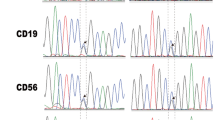Summary
Leukocyte cultures of a 16-year-old boy who was considered to have Klinefelter syndrome were examined. A 46,XX karyotype was found in 390 mitoses. In only 10 mitoses we could find a fragment beside the normal female karyotype. Clinical and cytogenetic findings indicate that the fragment consists of the weak fluorescent part of a Y chromosome. This case therefore supports the mosaicism theory for the origin of 46,XX males.
Zusammenfassung
Bei einem 16jährigen jungen Mann mit Verdacht auf ein Klinefelter-Syndrom wurde in 390 Mitosen aus Leukocyten-Kulturen ein Karyotyp mit den Gonosomen XX festgestellt. In nur 10 Mitosen konnte zusätzlich zu dem weiblichen Karyotyp ein Fragment gefunden werden. Die klinischen und cytogenetischen Befunde weisen darauf hin, daß es sich bei dem Fragment um den schwach fluorescierenden Anteil eines Y-Chromosoms handelt. Unser Fall unterstützt somit die Mosaiktheorie als eine mögliche Erklärung für die Genese der 46,XX-Männer.
Similar content being viewed by others
Literatur
Bartsch-Sandhoff, M., Schade, H.: Zwei subterminale Heterochromatinregionen bei einer seltenen Form einer 21/21-Translokation. Humangenetik 18, 329–336 (1973)
Borgaonkar, D. S., Hollander, D. H.: Quinacrine fluorescence of the human Y-chromosome. Nature (Lond.) 230, 52 (1971)
Borgaonkar, D. S., McKusick, V. A., Herr, H. M., de los Cobos, L., Yoder, O. C.: Constancy of the length of human Y-chromosome. Ann. Génét. 12, 262–264 (1969)
Caspersson, T., Zech, L., Johansson, C., Lindsten, J., Hultén, M.: Fluorescent staining of heteropycnotic chromosome regions in human interphase nuclei. Exp. Cell Res. 61, 472–474 (1971)
Červenka, J., Jacobson, D. E., Gorlin, R. J.: Determination of “Y-body” from hair-root sheats of males. New Engl. J. Med. 284, 856–857 (1971)
Court Brown, W. M., Harnden, D. G., Jacobs, P. A., Maclean, N., Mantle, D. J.: Abnormalities of the sex chromosome complement in man. Privy Council, Medical Research Council, Special Report Series No. 305. London: Her Majesty's Stationery Office 1964
De la Chapelle, A.: Analytic review: Nature and origin of males with XX sex chromosomes. Amer. J. hum. Genet. 24, 71–105 (1972)
De la Chapelle, A., Hortling, H., Niemi, M., Wennström, J.: XX sex chromosomes in a human male. First case. Acta. med. scand. Suppl. 412, 25–38 (1964)
Ferguson-Smith, M. A.: X-Y chromosomal interchange in the aetiology of true hermaphroditism and of XX-Klinefelter's syndrome. Lancet 1966 II, 475–476
Hecht, F., Antonius, J. J., McGuire, P., Male, C. G.: XXY cells in a predominantly XX human male: evidence for cell selection. Pediatrics 38, 982–985 (1966)
Lindsten, J., Bergstrand, C. G., Tillinger, K. G., Schwarzacher, H.-G., Tiepolo, L., Muldal, S., Höhfeld, B.: A clinical and cytogenetical study of three patients with male phenotype and apparent XX sex chromosome constitution. Acta endocr. (Kbh.) 52, 91–112 (1967)
Moorhead, P. S., Nowell, P. C., Mellmann, W. J., Battips, D. M., Hungerford, D. A.: Chromosome preparations of leucocytes cultured from human peripheral blood. Exp. Cell Res. 20, 613–616 (1960)
Murken, J.-D., Scholz, W.: Serologische Klärung der Herkunft der überzähligen X-Chromosomen bei einem XXXXY-Syndrom. Blut 16, 164–168 (1968)
Ohno, S.: Sex chromosomes and sex-linked genes. Berlin-Heidelberg-New York: Springer 1967
Palutke, W. A., Chen, Y., Chen, H.: Presence of brightly fluorescent material in testes of XX-males. J. med. Genet. 10, 170–198 (1973)
Pearson, P. L., Bobrow, M.: Technique for identifying Y-chromosomes in human interphase nuclei. Nature (Lond.) 226, 78–80 (1970)
Siebers, J. W., Vogel, W.: Structural aberrations of the Y-chromosome and the corresponding phenotype. Humangenetik 19, 57–66 (1973)
Solbach, H. G., Wiegelmann, W.: Differentialdiagnose des männlichen Hypogonadismus. Verh. dtsch. Ges. inn. Med. 76, 264–276 (1970)
Sperling, K., Kaden, R., Hirsch, W.: A casuistic contribution to the XX male problem. Humangenetik 17, 145–154 (1973)
Uchida, J. A., Lin, Ch.-Ch.: Fluorescent staining of human chromosomes: Identification of some common aberrations. Canad. med. Ass. J. 105, 479–482 (1971)
Author information
Authors and Affiliations
Rights and permissions
About this article
Cite this article
Bartsch-Sandhoff, M., Schade, H., Wiegelmann, W. et al. Ein Beitrag zur Genese von XX-Männern. Hum Genet 21, 245–253 (1974). https://doi.org/10.1007/BF00279019
Received:
Issue Date:
DOI: https://doi.org/10.1007/BF00279019




